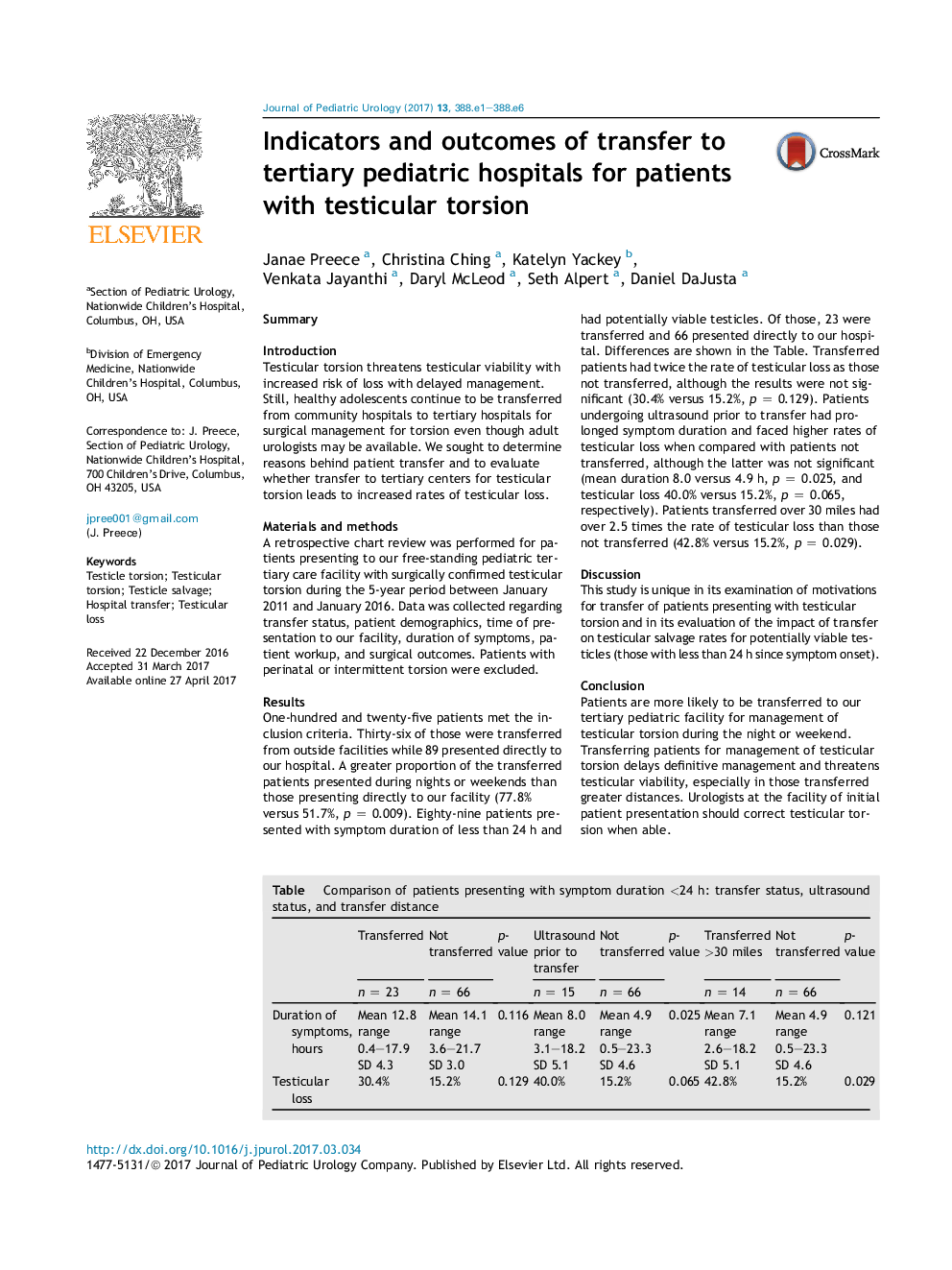| کد مقاله | کد نشریه | سال انتشار | مقاله انگلیسی | نسخه تمام متن |
|---|---|---|---|---|
| 5718556 | 1607135 | 2017 | 6 صفحه PDF | دانلود رایگان |
SummaryIntroductionTesticular torsion threatens testicular viability with increased risk of loss with delayed management. Still, healthy adolescents continue to be transferred from community hospitals to tertiary hospitals for surgical management for torsion even though adult urologists may be available. We sought to determine reasons behind patient transfer and to evaluate whether transfer to tertiary centers for testicular torsion leads to increased rates of testicular loss.Materials and methodsA retrospective chart review was performed for patients presenting to our free-standing pediatric tertiary care facility with surgically confirmed testicular torsion during the 5-year period between January 2011 and January 2016. Data was collected regarding transfer status, patient demographics, time of presentation to our facility, duration of symptoms, patient workup, and surgical outcomes. Patients with perinatal or intermittent torsion were excluded.ResultsOne-hundred and twenty-five patients met the inclusion criteria. Thirty-six of those were transferred from outside facilities while 89 presented directly to our hospital. A greater proportion of the transferred patients presented during nights or weekends than those presenting directly to our facility (77.8% versus 51.7%, p = 0.009). Eighty-nine patients presented with symptom duration of less than 24 h and had potentially viable testicles. Of those, 23 were transferred and 66 presented directly to our hospital. Differences are shown in the Table. Transferred patients had twice the rate of testicular loss as those not transferred, although the results were not significant (30.4% versus 15.2%, p = 0.129). Patients undergoing ultrasound prior to transfer had prolonged symptom duration and faced higher rates of testicular loss when compared with patients not transferred, although the latter was not significant (mean duration 8.0 versus 4.9 h, p = 0.025, and testicular loss 40.0% versus 15.2%, p = 0.065, respectively). Patients transferred over 30 miles had over 2.5 times the rate of testicular loss than those not transferred (42.8% versus 15.2%, p = 0.029).DiscussionThis study is unique in its examination of motivations for transfer of patients presenting with testicular torsion and in its evaluation of the impact of transfer on testicular salvage rates for potentially viable testicles (those with less than 24 h since symptom onset).ConclusionPatients are more likely to be transferred to our tertiary pediatric facility for management of testicular torsion during the night or weekend. Transferring patients for management of testicular torsion delays definitive management and threatens testicular viability, especially in those transferred greater distances. Urologists at the facility of initial patient presentation should correct testicular torsion when able.Table. Comparison of patients presenting with symptom duration <24 h: transfer status, ultrasound status, and transfer distanceTransferredNot transferredp-valueUltrasound prior to transferNot transferredp-valueTransferred >30 milesNot transferredp-valuen = 23n = 66n = 15n = 66n = 14n = 66Duration of symptoms, hoursMean 12.8 range 0.4-17.9 SD 4.3Mean 14.1 range 3.6-21.7 SD 3.00.116Mean 8.0 range 3.1-18.2 SD 5.1Mean 4.9 range 0.5-23.3 SD 4.60.025Mean 7.1 range 2.6-18.2 SD 5.1Mean 4.9 range 0.5-23.3 SD 4.60.121Testicular loss30.4%15.2%0.12940.0%15.2%0.06542.8%15.2%0.029
Journal: Journal of Pediatric Urology - Volume 13, Issue 4, August 2017, Pages 388.e1-388.e6
